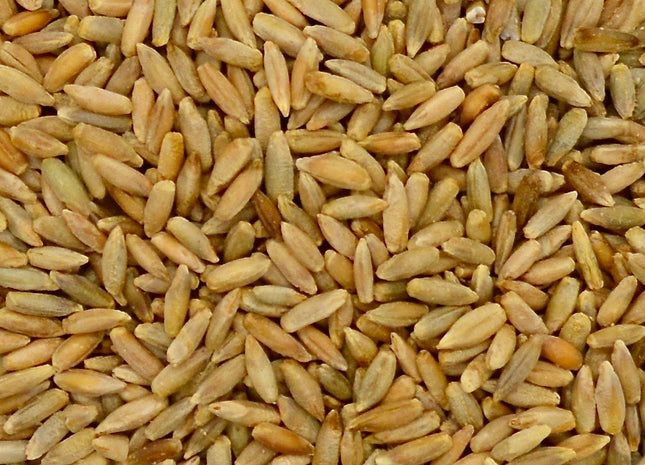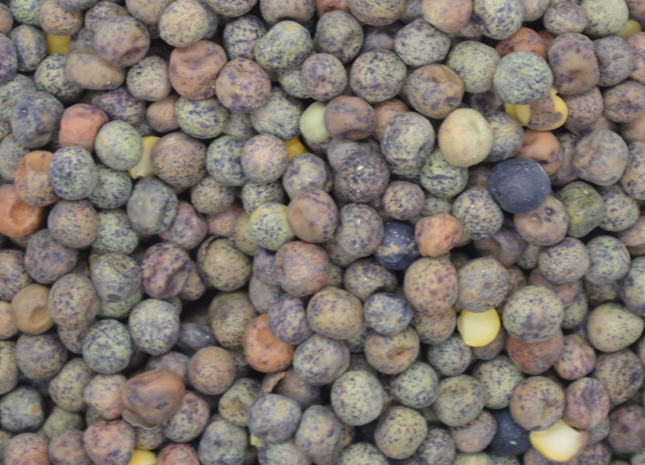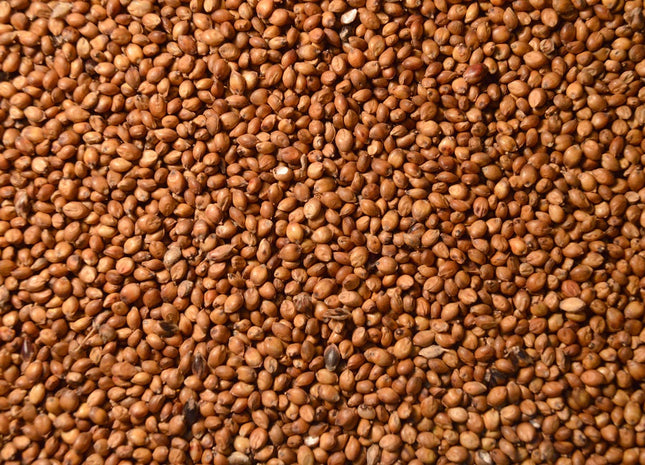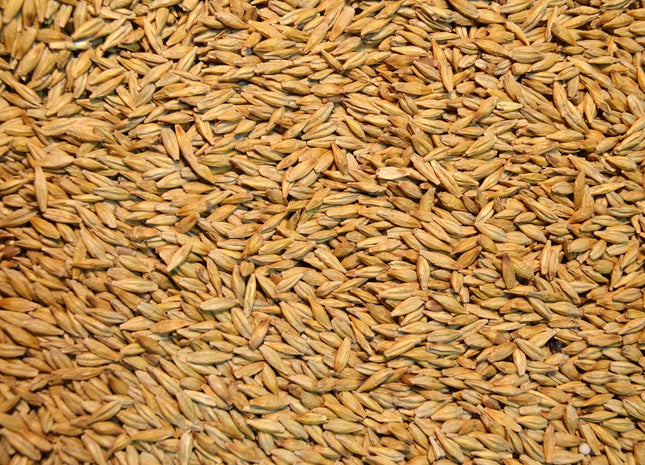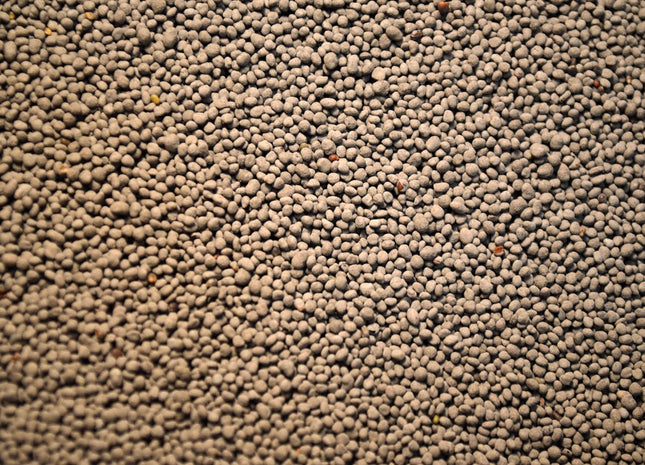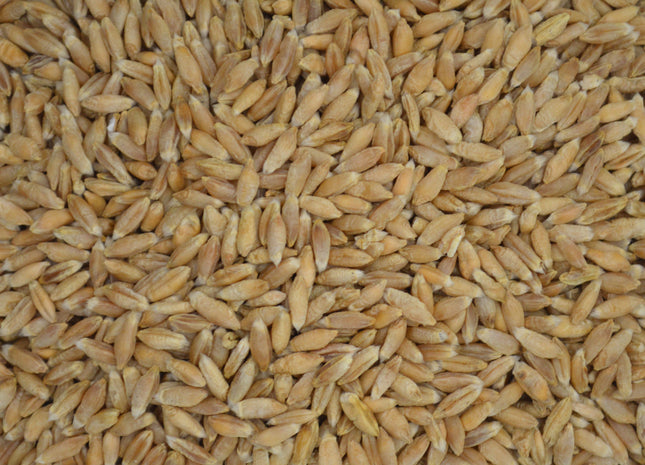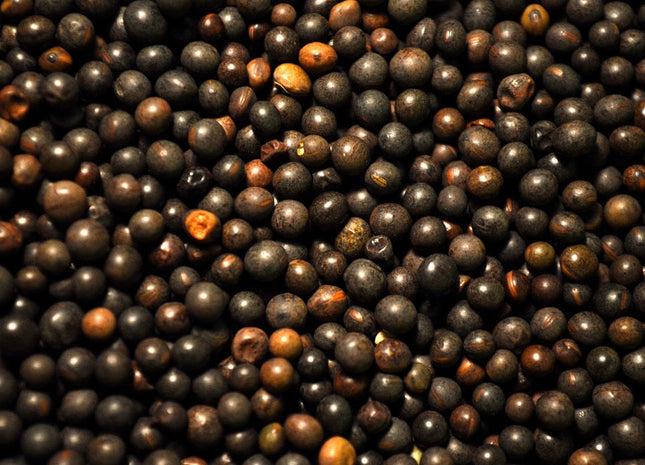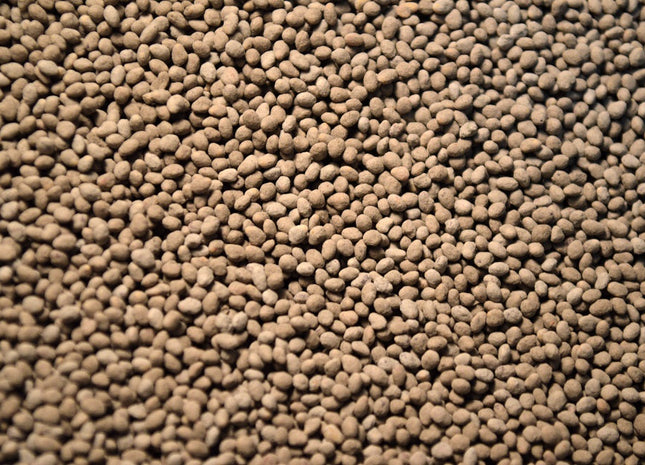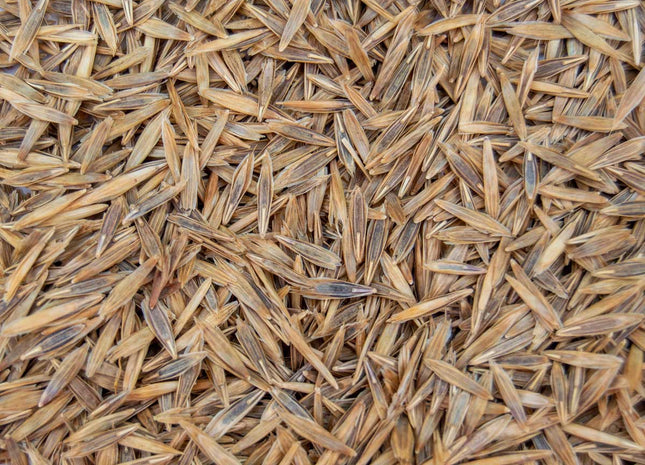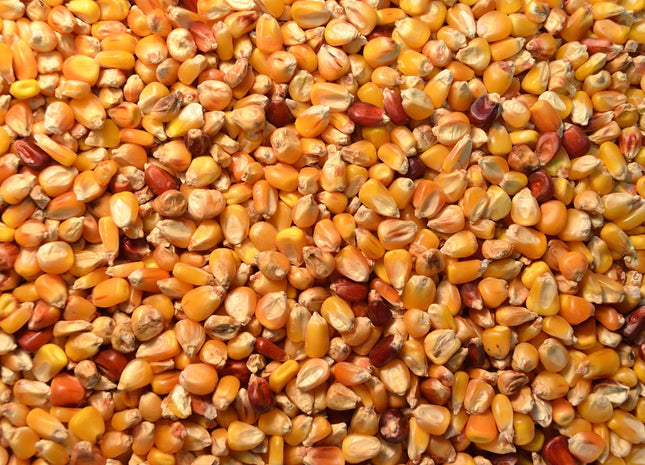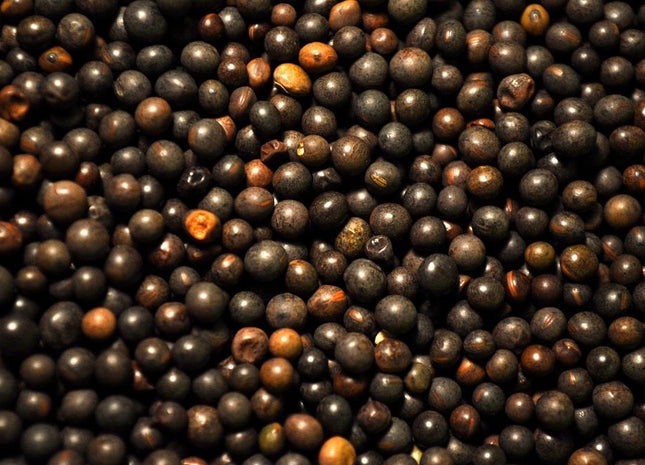Browse our extensive lineup of monoculture cover crop seeds.
Looking for a diverse cover crop mix? Browse Pre-Made Mixes or Food Plots.
Single Species Seed


Buckwheat (Mancan)
Buckwheat is a fast establishing broadleaf that works great as a warm season cover crop. Buckwheat is also known for being a phosphorus scavenger. Which means it can take up more phosphorus efficiently than other plants. Being a short season plant around 45-60 days, it can still produce viable seed throughout the growing season. In a situation where the one plant is grazed it can drop a seed down to take that previous plant's spot to help prevent weeds. This plant while dropping and producing these seeds can also flower making it a great species for pollinators.
from $1.05 per lb


Sunflower (Black Oil)
Sunflower is renowned for its extensive and prolific root system and its ability to soak up residual nutrients out of reach for other commonly used covers or crops. This species can also take advantage of short growing seasons in case of damaging hail or poor emergence to cash crops. If planning to harvest for oil or seed or simply to attract birds, sunflowers have very similar planting and harvesting methods to that of corn. Because insects are attracted to the bright colors of sunflower heads, pollinators and beneficials such as bees, damsel bugs, lacewings, hoverflies, minute pirate bugs, and non-stinging parasitoid wasps are often found in fields of sunflower and in following crops. Sunflowers also work very well in cover crop cocktails/mixtures. With rapid early season establishment, additional covers under the canopy that normally don’t grow under cool conditions can begin to take advantage of warmer and favorable weather when sunflowers are growing slower. With upright growth and anchored plants in the soil, surrounding vining/climbing cover crop plants can support their own growth by working their way up to reach sunlight thereby providing the structure they need to grow. Because sunflowers can add significant biomass production in just a short growing season, they can also serve as additional forage or silage for livestock feed.
from $0.90 per lb


Cereal Rye (Elbon)
Cereal Rye has an excellent fibrous root system that alleviates surface compaction. Rye can be successful planted later then almost any other cover crop due to its low germination and growth temperature requirements. Cereal rye is known for being the best cereal crop at retaining residual N. It's typical for a fall planted cereal rye crop to scavenge on average 25 to 50 lbs of N, with cases scavenging in excess of 100 lbs of N. The vigorous spring growth has successful weed suppression through competition and allelopathic chemicals. Rye can be terminated in the spring through the alternative methods of rolling, mowing, or crimping after boot stage. Rye will out yield any other cereal crops when planted in droughty, infertile, or sandy soils.
from $0.30 per lb


Sunn Hemp
Sunn hemp is an erect, tall growing legume with an anchoring tap root. The leaves are high in protein for grazing and especially popular with small ruminants like sheep, goats, and deer, but cattle will also eat the leaves. The stalk is very lignified making this a poor species to use in a hay mix.
from $2.00 per lb


Winter Peas (Austrian)
Austrian winter peas are good companions to fall mixes, especially when combined with hairy vetch. If planted in early fall, there can be good growth for fall grazing as a protein source in the mix and they will grow much later into the fall than spring peas. In order to maximize winter survival chances, winter peas need to be planted relatively late (about the middle of wheat planting season) and deep, up to 3 inches. These conditions will help protect the growing point of the pea and assists in survival in colder climates.
from $0.80 per lb


Forage Collards (Impact)
Impact forage collards are a cross between Georgia Southern collards and another leafy brassica and are one of the best grazing brassicas on the market. The large, smooth leaves are very palatable and our testing shows that these collards have the highest protein content in the brassica family. Collards can withstand some of the widest ranges of weather, from hot and dry in the summer, and surviving temperature down to the low single digits in the winter.
from $2.28 per lb


Radish (Nitro)
Rapid fall growth in short windows, allows radishes to fit perfectly into a traditional corn and soybean rotation. Radish residue breaks down very quickly in the spring, leaving a clean seed bed until early April. The residue has been proven to inhibit small seeded annuals from germinating. Nutrients that were scavenged are readily released back into the soil for the subsequent crop. A field planted in radishes, will allow the soil to dry and warm faster in the spring. The large root channel left behind is rich in nutrients, allows tremendous water infiltration, reduces water erosion, and a path for crops roots to follow through compacted soil layers. During decomposition, radish biofumigates the soil which can reduce pest and nematode populations.
from $1.55 per lb


Turnip (Purple Top)
Purple top turnips have been a staple grazing brassica for many years and are commonly used in late summer planted grazing mixes, often with a cool season cereal. Turnip bulbs are storehouses of nutrition and energy and are very valuable to winter grazers.
from $1.45 per lb


Crimson Clover (Dixie) - OMRI Inoculated
Crimson clover is one of the fastest growing, fastest establishing clovers. Known for its beautiful, deep red, cone shaped bloom, crimson clover is one of the most aesthetically pleasing cover crops and a popular choice for pollinator insects. For a more cold tolerant and higher biomass version, consider Kentucky Pride crimson clover.
from $1.55 per lb


Rapeseed (Trophy)
Rape's rapid forage growth produces quality pasture equivalent to alfalfa, with a crude protein value around 16-17%. Boasted for its nutrient scavenging abilities, rape can accumulate potentially large amounts of residual N up to 120lbs N/A. Also, root exudates secreted by rape are known to aid in turning insoluble P into a more available form. Rapes seed cost is by far the cheapest of all the brassica species, generally less than $1/lb. Adding rape in between wheat crops has been shown to greatly reduce take-all in wheat. Rape has an excellent, deep penetrating tap-root with a dense fibourous root mass surrounding the tuber.
from $1.05 per lb


Spring Forage Pea (4010 Non-GMO)
Spring peas are one of the fastest growing spring legumes. Planted in spring after the harshest winter cold has passed, spring peas will tolerate some light freezing. Peas are commonly planted with oats as a high quality spring feed either for hay or grazing or even a green manure.
from $0.55 per lb


Crimson Clover (Kentucky Pride) - OMRI Inoculated
Kentucky Pride is an improved variety of crimson clover selected for more cold tolerance and more production (taller, deeper roots, more basal leaves and more tillering) than varieties like Dixie. Kentucky Pride crimson clover is a very fast establishing clover.
from $1.65 per lb

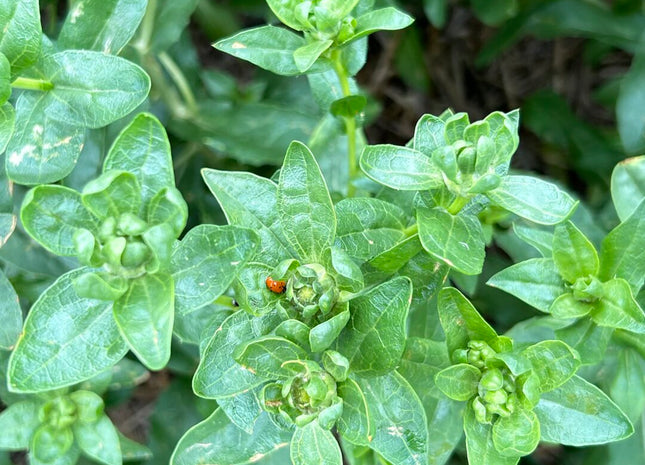
Safflower (Baldy)
Safflower is a drought tolerant, annual, warm season broadleaf that can be seeded in cool soils. Safflower is exceptional at breaking hard pans, encouraging water and air movement into the soil profile, as well as scavenging nutrients from depths unavailable to most agronomic crops. It is capable of doing this due to its impressive taproot which has been observed to grow 8-10 feet in ideal conditions. Safflower provides excellent forage for grazing but most varieties become prickly with maturity, rendering the plants unpalatable for livestock. Baldy safflower is one of the world's first spineless safflower varieties and has been developed specifically for grazing and cover crops. Baldy can be handled with bare hands even at maturity and is palatable for livestock grazing. Green Cover Seed owns the exclusive marketing rights for Baldy spineless safflower.
from $0.85 per lb


Cowpeas (Iron & Clay)
Cowpeas are one of the most popular warm season legumes. They love the heat, they tolerate drought, and they offer nitrogen fixation in a soil building mix, or higher protein in an annual grazing mix. Cowpeas have a long maturity which means when they are planted at the beginning of summer, they can achieve a lot of growth before temperatures cool down into fall.
from $1.21 per lb


Mung Beans
Mung beans are a warm-season legume known for their remarkable heat tolerance and drought resistance. They exhibit rapid growth, maturing in just 65 days. One advantage of mung beans over cowpeas is that their seed pods remain intact, unlike cowpeas, making them an excellent source of late-fall protein for grazing livestock or wildlife. However, it's important to note that mung beans are highly susceptible to cold weather and require a minimum of 60 frost-free days to ensure successful growth. They can be used for both hay production and grazing and are compatible with peanut inoculant. Mung beans typically reach a height of around 3 feet and have a low to medium water usage. Their strengths lie in nitrogen fixation, forage production, and hay production.
from $1.36 per lb

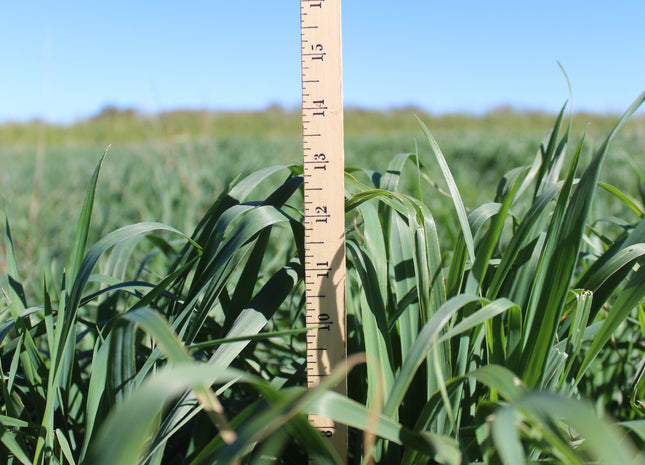
Black Oats (Cosaque)
Cosaque black oats offer several advantages over traditional oats, including superior nutritional value, digestibility, palatability, and a robust tillering capacity. They exhibit forage yields comparable to cereal rye and demonstrate good winter hardiness, often serving as a winter annual crop in southern regions. Notably, these oats thrive even in low-quality soils, contributing to soil restoration and enrichment due to their exceptional root system. A great fall grazing option across the U.S. and a great overwintering grass as you get south of Interstate-70.
from $0.35 per lb


Balansa Clover (Fixation)- OMRI Inoculated
FIXation balansa clover is the most cold-tolerant annual clover, surviving temperatures as low as -14. Where it does overwinter, FIXation is capable of growing over 200 lbs of nitrogen biomass and it even has a hollow stem making it an option for roller crimping. This can also be used for a high yielding, high protein feed before transitioning to the next summer crop. To have the best chance at winter survivability, plant earlier than other overwintering species. For more information on FIXation balansa clover visit https://fixationclover.com.
from $2.95 per lb


Sweet Clover (Hubam White) - OMRI Inoculated
Hubam White Sweet Clover can produce up to 9,000 lbs dry matter per acre over a summer after being oversown into a grain crop or direct seeded with a spring grain nurse crop. While its taproot is shorter and more slender than that of its biennial cousins, it still loosens subsoil compaction. Annual sweetclovers work best in the Deep South, from Texas to Georgia as they are not frost tolerant. There, they establish more quickly than the biennial types and produce more biomass in the seeding year in southern regions.
from $3.61 per lb


Phacelia
Phacelia enhances soil N uptake, boosts soil organic matter with C, suits low to medium N soils for feed/hay. While forage yield is modest, it's palatable to livestock even at maturity. Best planting times: early spring or late summer (like alfalfa), but it blooms in spring planting and aids potassium availability.
from $4.35 per lb


Radish (Smart)
Green Cover Seed is proud to market the all new Smart Radish. It is bred specifically for the cover crop and soil health market. The variety has a trait for higher plant tillering to provide more leaf area and higher plant biomass than many other radish options for forage, soil, cover and green manure. Larger leaves mean more solar collection area to harvest the sun’s energy, and the smoother leaf means it’s better for forage and grazing.
from $2.33 per lb


Red Clover (Medium) - OMRI Inoculated
With similar forage yields, crude protein and better digestibility when compared to alfalfa, red clover can be an excellent forage alternative to add to your operation. You can harvest your first cutting 60-70 days after a spring seeding and on every 30-35 day intervals after initial harvest. With its vigorous spring growth, this clover has the capability of suppressing weeds. Red clover is less invasive than white clover because of its shorter life span and the lack of rhizome or stolon rooting structures. It's deep taproot can extend up to 3ft into the soil profile and finer rooting structure in the top 5" can really aid in breaking up compacted soils. Red clover flowers are known to attract many pollinator and beneficial insect species. If P leaching is a concern, red clover has been observed to leach only 1/3-1/5 the amount of P as ryegrass or radishes.
from $3.00 per lb


Hairy Vetch (Winter Warrior)
Hairy vetch is the most cold tolerant winter annual legume. Tolerating temperatures as low as -30 degrees, this is best planted before the first frost in the fall and then it will resume growth in the spring. Hairy vetch is slower to green up and has slower spring growth compared to cereal rye and wheat but once it does get going, it grows very fast, doubling it’s growth each week through the month of May. With patience and a delayed corn planting, a full stand of vetch can consistently produce over 200 lbs of nitrogen in its biomass. As part of a winter cover crop or forage mix, vetch is commonly grown with rye or triticale.
from $2.54 per lb


Sugar Beets Non-GMO
Sugar beets, a versatile broadleaf cover crop, bring a formidable combination of deep-rooted prowess and frost resistance to your agricultural arsenal. Their robust taproots can penetrate stubborn hardpans, with the majority of root growth hidden beneath the surface. These beets are not only sweet in content but also a preferred choice for both wildlife and cattle grazing. When grazed early, they display remarkable regrowth potential.
from $3.30 per lb


Forage Soybeans (Laredo)
Laredo Soybeans are an older soybean variety that is distinguishable from most other soybean varieties since the actual seed is black in color. While growing it will look like a typical PPS (Photoperiod Sensitive) soybean plant. PPS is the developmental response by the plant due to the relative lengths of light and dark periods (Day and night) that adjust its flowering time. These soybeans are excellent in both grazing and or hay situations.
from $1.60 per lb


Plantain (Boston)
Plantain is a low-growing forb that, like chicory, is high in minerals. It also contains a natural antibiotic compound that helps reduce infections and also modifies rumen fermentation to improve animal performance, similar to an ionophore like Rumensin. It grows very well on compacted soils and helps loosen them.
from $5.30 per lb


Kale (Bayou Kale-Rape Hybrid)
This hybrid plant is the product of blending two brassica parent plants: kale and forage rape. This innovative hybrid boasts a unique combination of qualities, harnessing the quick establishment capabilities of forage rape and the exceptional winter resilience of kale. The resulting kale-rape hybrid stands as a superior source of high-protein forage, tailor-made for winter grazing. Its accelerated growth, robust vigor, and resilience to harsh winter conditions make it an ideal choice for livestock feed.
from $3.00 per lb


African Cabbage
African cabbage, a robust and rapidly growing brassica, thrives in a variety of warm season mixes, which makes it an intriguing option for interseeding into corn mixes. What sets it apart is its unique ability to stand tall and keep its leaves even in the face of cold weather, making it an exceptional choice for a snow-catching cover crop. Its enduring residue and strong root system enable captured snow to seep into the soil, enriching the moisture content in your land.
from $2.38 per lb


Common Vetch
Common vetch, is a valuable cover crop widely used in the industry. As a leguminous plant, it provides nitrogen fixation, improving soil fertility. Common vetch's extensive root system prevents erosion and helps control weeds, making it a natural choice for sustainable farming. It enhances soil quality by adding organic matter, supports crop rotation systems, and provides early-season ground cover. Additionally, it can serve as a habitat for wildlife and, in some cases, offer forage for livestock. Common vetch's cold tolerance makes it suitable for various climates, but it is not nearly as cold tolerant as that of Hairy vetch.
from $1.75 per lb

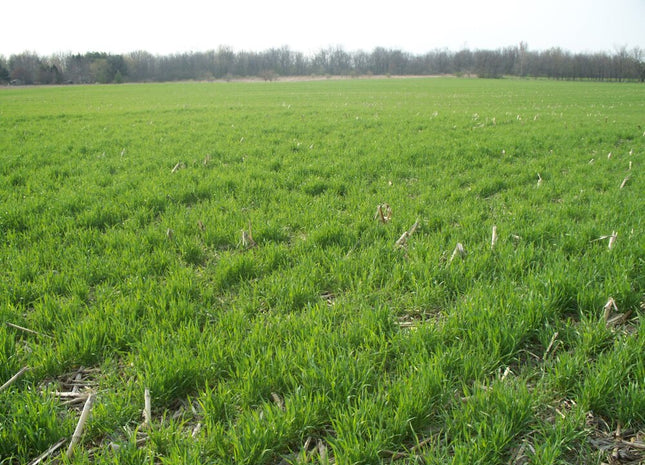
Cereal Rye (Hazlet)
Cereal Rye has an excellent fibrous root system that alleviates surface compaction. Rye can be successful planted later then almost any other cover crop due to its low germination and growth temperature requirements. Cereal rye is known for being the best cereal crop at retaining residual N. It's typical for a fall planted cereal rye crop to scavenge on average 25 to 50 lbs of N, with cases scavenging in excess of 100 lbs of N. The vigorous spring growth has successful weed suppression through competition and allelopathic chemicals. Rye can be terminated in the spring through the alternative methods of rolling, mowing, or crimping after boot stage. Rye will out yield any other cereal crops when planted in droughty, infertile, or sandy soils.
from $0.27 per lb


Grain Sorghum (Food Plot)
Grain sorghum provides an excellent opportunity for feeding wildlife. The grain heads, which mature in late summer to early fall will attract the wildlife species and provide superior nutrition. Grain sorghum is an excellent option for upland birds in particular.
from $3.05 per lb


Proso Millet (White)
Proso millet is one of the most drought tolerant and cost effective annual grasses. It is the shortest growing millet though it grows taller in the northern plains than it might in the central or southern plains. Heading out in less than 60 days, this is a great plant for game bird mixes.
from $0.70 per lb


Japanese Millet
Japanese millet, known for its quick maturity, usually offers a lower forage yield compared to other millet varieties. However, it stands out for its superior post-maturity palatability when compared to foxtail millet and its impressive regrowth capabilities. Additionally, Japanese millet exhibits remarkable resilience to waterlogged soils, thriving even in standing water, making it a valuable choice for enhancing duck habitat and nourishment in food plots.
from $0.90 per lb


Winter Lentil (Morton)
Winter lentils are a lesser used species but offer several benefits. Lentils are relatively low growing and modest in their growth however, they consistently overwinter in Zone 5B where winter temperatures can drop below -25 degrees F. Winter lentils can be added with winter cereals and other winter legumes to have a more diverse overwintering cover crop.
from $1.00 per lb


Faba Bean
Faba beans are one of the oldest plants under cultivation, having been grown in ancient Greece and Rome. Unlike other beans, they prefer cool weather, allowing them to be planted — and harvested — much earlier. Faba beans have a distinct flavor and creamy texture that make them a fine ingredient for a wide variety of dishes. This legume is a natural, organic fertilizer (called a green manure) that fixes nitrogen in the soil for other plants to use. By planting faba beans in your garden, food plot or field, you can improve soil fertility at the same time without needing to add other fertilizers and amendments.
from $0.85 per lb

Berseem Clover (Balady) - OMRI Inoculated
Berseem clover produces a non-bloating, high quality forage, that's more palatable than alfalfa. Berseem forage has been observed to maintain a CP content of 28-30% throughout harvesting regiments, which is slightly higher than crimson clover or alfalfa. Berseem clover has low water requirements and can provide strong biomass recovery after being mowed. A rapidly, consistent stand can be achieved because germination can occur in just 7 days and minimal hard seed counts. This clover produces flowers which are self-sterile so reseeding is not a concern. These flowers do provide a great pollen source, which is highly sought after by honeybees. Berseem can be controlled easily with glyphosate or when planted in colder regions will winterkill. With good shade tolerance, this species can be utilized for interseeding into crop systems or forage mixtures.
from $2.35 per lb

Brown Top Millet
With extremely rapid growth, browntop millet can fill narrow growing windows to produce a nice quality forage. Under ideal conditions seed will germination within 5 days and forage or seed will be ready to harvest within two months time. Very fine stems and leaves allows plant material to dry down effectively for dry hay production. Browntop millet is an effective nurse crop, much like oats, in stabilizing erosive hill slopes and providing cover for slower growing target species to become established. Research has shown browntop helps to suppress root-knot nematode within the soil. This species is very inexpensive, providing a full stand for less than $15 an acre. With the ability to easily reseed and that seed to remain viable in the soil profile for years, makes browntop millet an excellent regenerating food plot for wildlife.
from $1.05 per lb


Alfalfa (Vernal) - ORMI Inoculated
Alfalfa is the most common and most productive perennial legume. It is usually used as a perennial monoculture for hay but at low rates and with good rotational grazing, alfalfa can also be used in pasture mixes to boost diversity and animal performance.
from $3.25 per lb


Chickpeas (Desi)
As the most heat tolerant of the cool season legumes, chickpeas offer a versatility that can be used in both warm and cool season mixes. Though not a great biomass producer, chickpeas are very drought tolerant and can help cover the ground in the midst of a summer drought. This taprooted plant can be used with grasses to add diversity and help break up compaction. As a legume, chickpeas will also fix nitrogen into the soil.
from $0.80 per lb


Spring Oats (Rushmore)
Spring oats are an excellent choice for quick ground cover in the spring or fall. Rapid growth aids in stabilizing disturbed or bare soil from environmental conditions. Spring oats make a great addition to any spring grazing or forage mix providing ample tonnage for your livestock. Oats can be easily chemically terminated and fall plantings commonly winterkill. Residue from oats suppress winter annuals and protect the soil throughout the winter and will decompose rapidly in the spring. Allelopathic chemicals released by the decomposing residue suppress weed germination for a few weeks. The high quality oat forage is more palatable than rye or wheat. Also, oat is less prone to insect problems than either wheat or barley.
from $0.32 per lb


Florida Broadleaf Mustard (Shield)
Mustard produces significantly more glucosinolates than other brassicas, which biofumigates the soil during decomposition, proving to be toxic to many soil pathogens and pests. If this is your goal than another mustard species should be utilized, since this cultivar isn't as suited for this purpose. Growing mustard in a potato rotation was observed to increase tuber quality and yields similar to that of chemically fumigated fields. Other documented effects of having mustard in your rotation is suppressing potato early dying and reduced root rot in pea rotations. Some customers are concerned that these mustards are difficult to control like their wild cousins but actually they can be easily terminated with many commonly utilized herbicides. Mustard forage is known for its ability to be utilized as a natural dewormer in grazing systems.
from $2.18 per lb

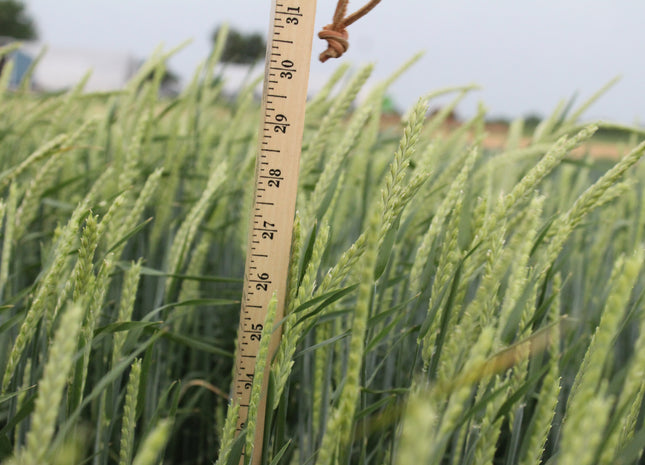
Spring Forage Barley (Lavina) - Beardless
Barley has relatively low water usage compared to other cover crop species, especially during earlier growth stages. Under poor fertility conditions, barley would be a good choice and can help render P & K available for your next crop. Barley provides a good feed quality grain that can be harvested 2-3 weeks earlier than wheat which then allows your double crop/cover to be planted sooner.
from $0.32 per lb


Spring Lentil (Crimson)
Lentils thrives in cool, dry conditions where they can remain relatively free of disease hence, they are commonly grown in the norther Great Plains. With a shallow rooting structure that doesn't have the ability to reach subsoil moisture, lentils are a great option in front of cereals or deep rooting crops. If excessive moisture is present during the growing season it will delay plant maturity. This will be excellent for producers who want to plant a summer fallow mixture where the mix can continue to grow under ideal conditions. Lentils are known for their ability to emerge through thick cereal stubble due to their strong seedling vigor. With rapid seed germination, seedlings generally out grow the threat of insects or disease pressure during establishment. Lentils can also house mycorrhizal fungi. Mature lentil straw can be an option for feed as it is much higher in CP, digestibility and palatability when compared to cereal straws.
from $0.95 per lb


Switchgrass (RC Big Rock)
RC Big Rock Switchgrass is a new late season variety of upland switchgrass developed from Cave-in-Rock. This is a native perennial warm season grass that is extremely productive, reaching 8 feet tall on the best soils of the Midwest. It also establishes faster than most native grasses because it has larger seeds with reduced dormancy and more seedling vigor. RC Big Rock can grow 2 ft tall in 2 months in the seeding year. This is a multi-purpose variety to be used for wildlife habitat, soil conservation, and forage throughout the greater Midwest where annual rainfall averages 30-50”.
from $16.55 per lb

Winter Wheat (GA Gore Soft Red) - Beardless
The soft red winter wheat, an awnless variety, stands at a medium height with its moderate-strength straw. Its resistance to diseases and pests makes it a nice option as a winter cover crop for grazing, weed suppression, and erosion control.
from $0.32 per lb


Brown Mustard (Kodiak)
Mustard produces significantly more glucosinolates than other brassicas, which biofumigates the soil during decomposition, proving to be toxic to many soil pathogens and pests. To best utilize these glucosinolates, mature green vegetation should be turned into the soil. In no-till operations you will still benefit from having this species for this use. When allowed enough growing season, brown mustard stem residue can remain erect throughout the winter months, aid in capturing snow to help build moisture in the soil profile. Growing mustard in a potato rotation was observed to increase tuber quality and yields similar to that of chemically fumigated fields. Other documented effects of having mustard in your rotation is suppressing potato early dying and reduced root rot in pea rotations. Some customers are concerned that these mustards are difficult to control like their wild cousins but actually they can be easily terminated with many commonly utilized herbicides.
from $2.38 per lb


Sesame
Sesame is a warm season broadleaf that is normally grown for the oil content of the seed. It is one of the oldest cultivated plants and has been grown by people for over 4,000 years. Sesame loves hot weather and can grow with very limited water as well as being fairly tolerant of low pH soils. Sesame can grow 5-6 tall and will put on bell-shaped, white and purple flowers late in the season which makes it a great addition to a full season pollinator mix. Sesame has little to no forage value as livestock will not graze it, but it can still be a good addition to a grazing mix so there is some taller standing structure after the cattle have grazed the paddock.
from $2.15 per lb


Sweet Clover (Yellow Blossom) - OMRI Inoculated
Yellow blossom sweetclover is not a true clover but is probably more closely related to alfalfa. Sweetclover leaves look much like alfalfa, but the margins of alfalfa leaflets are serrated only on the tips. Sweetclover leaflets are serrated around their entire margin. It is typically a biennial, grows 2-6 feet high, and as the name implies, produces yellow flowers. When compared to the white flowering types of sweetclover, yellow blossom blooms roughly 2 weeks earlier and also matures earlier, usually grows less upright, possesses finer stems, and is less productive and less winter-hardy. However, yellow blossom sweetclover persists better in pastures and tolerate adverse conditions better than white varieties. In temperate climates with mild summers it can survive and thrive through a second year of production. Yellow blossom sweetclover adds lots of nitrogen and organic matter to a system.
from $3.75 per lb

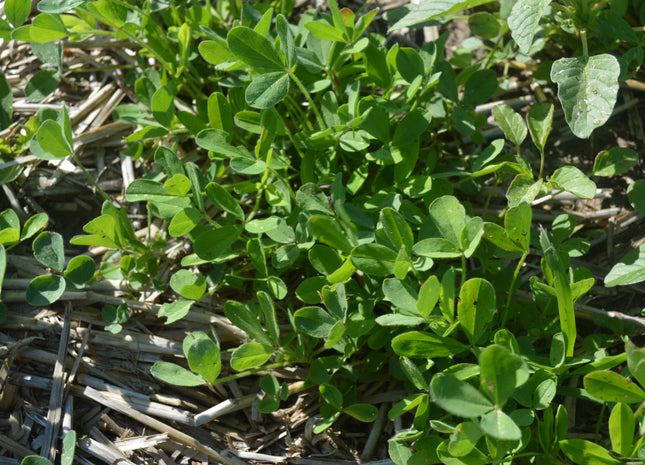
Berseem Clover (Frosty) - OMRI Inoculated
Berseem clover is a Mediterranean type that is salt tolerant, nitrogen fixing, and does well on light textured, sandy soils. Compared to other varieties of berseem clover, Frosty is later maturing, more cold tolerant, more productive, and has greater nutritional value. Frosty berseem clover can be overseeded into thinning stands of alfalfa as it looks very similar (before it blooms white) and it has excellent regrowth after cutting. For more information on Frosty berseem clover visit https://frostyclover.com.
from $3.85 per lb

Sorghum Sudan (Super Cover)
Super Cover is an excellent sorghum sudan for anybody looking for a high carbon, warm season grass to help prevent erosion, build soil, and even catch snow if left through the winter.
from $1.10 per lb


Sudangrass (Piper)
Sudangrass is a super fast growing, fine stemmed warm season annual grass. If summer weed suppression was the goal, this would be one of the best species to accomplish that. Sudangrass is commonly crossed with sorghum to make sorghum-sudan which Takes the fast, tall growing, fine stemmed traits of sudangrass and combines it with the wider leaf and oftentimes higher forage quality of sorghum. For the best grazing digestibility, a BMR (brown midrib) sorghum sudan is usually used which has less lignin.
from $1.41 per lb


Siberian Kale
Siberian Kale like many other brassicas are a great addition to mixes for deep taproots to access nutrients and water deep in the soil profile. This deep taproot allows for following crop roots or water to go deep in the soil profile. The wide leaf and good palatability of kale works great in grazing mixes for livestock. A good cold tolerant brassica can last deep into the fall for good fall and early winter grazing.
from $2.50 per lb


Cucurbit Blend
The cucurbit plant family includes plants like squash, pumpkins, and gourds. These warm season annual broadleaves are known for being viny which can be a very desirable trait to have in a cover crop blend. In the case of a row skip when planting or a troublesome soil spot in the field, nearby cucurbits will vine out to soak up the sun where nothing else is growing. These cucurbit fruits can also add nutrition to winter stockpile forage mixes as the cold weather softens their outsides and cattle learn to eat the seeds and fruit flesh.
from $3.05 per lb

Alsike Clover - OMRI Inoculated
Alsike clover is a perennial that thrives in low lying ground. For pastures or meadows with poor drainage and occasional water logging, this would be the first clover to try. Growing 2-4 feet tall with pink flowers, this adds a pollinator attracting and nitrogen fixing species to perennial pasture mixes. It should be considered that alsike clover can be toxic to horses.
from $4.05 per lb


Radish (Nematode Control)
Nematode Control Radish possess a unique mechanism for nematode management. They release a specific biochemical compound from their roots, which prompts cyst nematode eggs to hatch prematurely. Subsequently, these nematodes adhere to the radish root, but struggle to acquire sufficient sustenance. Since radishes lack the nutrients essential for their survival, the nematodes either perish or fail to reproduce. Nematode-controlling radishes are selectively bred to optimize control over specific nematode species, offering an effective solution for managing nematode populations.
from $2.60 per lb


Arugula (Roquette)
What is usually known as a salad green, arugula can also be used in cover crop mixes. Arugula is a dense, low growing brassica other than its white flower when it bolts. The bitter taste and smell of arugula is an indication that the glucosinolates give it a natural biofumigant use similar to mustards. Arugula is a very long season plant and if spring planted will stay green late into the fall.
from $2.25 per lb


White Clover (Stamina Intermediate) - OMRI Inoculated
White Clover is an excellent choice for a perennial clover. The Stamina variety was developed to be more heat and drought tolerant than most other white clovers. Being a legume this plant can cause bloat, but rarely when it is in a mix with grasses. White clover is also a great choice for areas that have saturated soils.
from $6.05 per lb

Pearl Millet (Exceed BMR)
Pearl millet is among the best grazing or haying millet varieties. Exceed BMR Pearl Millet also offers the BMR trait allowing the animal to better digest the plant for optimal nutritional efficiency to the animal. Pearl millet is very adaptable to its growing environment with great tillering allowing for more forage and better ground coverage with less seed.
from $2.40 per lb


Foxtail Millet (White Wonder)
White wonder foxtail millet is used primarily for hay production. The stem is not as fine as Golden German Millet but it will get taller in height, approximately three feet, given adequate moisture. Expect to cut hay in approximately 50-55 days after planting. Windrow when heads begin emerging from the boot. Foxtail millet is also a great addition to summer grazing or wildlife mixes.
from $0.80 per lb

Sorghum Sudan (Endurance Aphid Tolerant BMR Dwarf)
Endurance aphid tolerant BMR dwarf sorghum sudan is bred for short stature and high digestibility. Don't mistake shorter stature for less biomass, though. The dwarf trait simply shortens the length in between the leaves, called the internode length, while still growing the same number of leaves. The shorter plant makes it easier for livestock to graze and utilize efficiently.
from $1.55 per lb

Triticale (SY TF 813 Triticale) - PVP
This product cannot be shipped to AZ or CA. 813 is a winter triticale variety adapted to the Southern and Central Great Plains. This triticale is awnletted meaning it has very short beards. 813 is a medium maturity, rust and wheat streak mosaic tolerant variety. It should be used for forage production and is known for excellent silage yields.
from $0.33 per lb


Winter Camelina
Winter Camelina is the most cold tolerant brassica with the ability to overwinter in most areas. This brassica grows a small rosette in the fall and then grows upright after winter dormancy. This is a good brassica to add to later planted fall mixes in cases after fall harvested cash crops. Camelina can be a great addition ahead of spring cash crops with its ability to scavenge nitrogen and phosphorus.
from $2.38 per lb

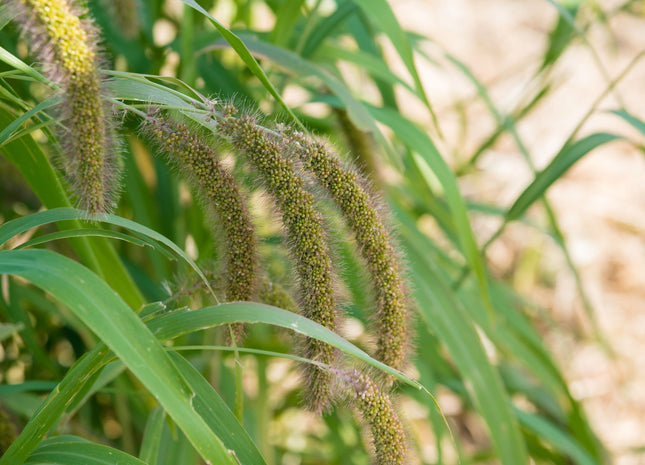
German Millet (Golden)
German millet is a warm season grass that can be planted earlier than sorghum sudan or pearl millet. Though it is not as productive as the aforementioned grasses, german millet makes a cost effective hay crop, ready for cutting about 55-60 days after planting. It does not have good regrowth which lends itself well to establishing the next crop without lingering competition after haying occurs.
from $0.75 per lb
- Out of Stock

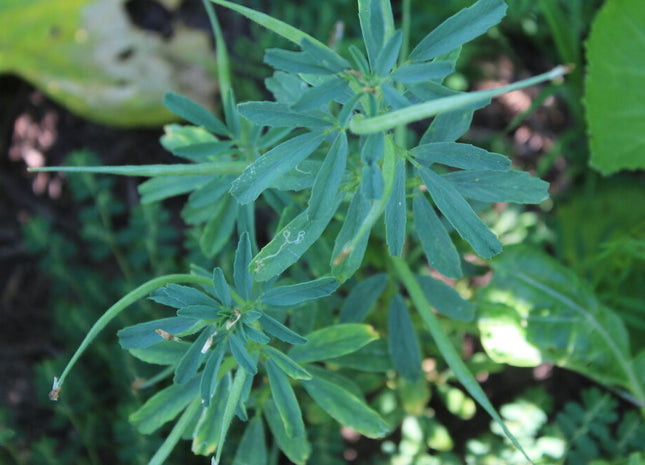
Fenugreek - OMRI Inoculated
Fenugreek is not commonly known in the US, but we think it should be. This legume is commonly used in pastures and haying situations. It is known for its livestock health benefits including promoting reproductive and digestive health. In fact some of the top soil scientists in the world recommend adding fenugreek to every livestock diet. This plant looks similar to clover with flowers resembling common peas. As a warm season plant, fenugreek loves sunlight and heat and makes a great addition to any warm season mix for its grazing and N-fixing characteristics. *Please note this is NOT food grade seed and is NOT recommended for human consumption.
from $1.89 per lb

Hairy Vetch (MT)
Hairy vetch is one of the most winter hardy legumes. Being more winter hardy than common vetch, hairy vetch has the potential to withstand temperatures in excess of 5F with no cover. This species is known to have a great rooting system, with a tap root that will extend 1 to 3 feet into the soil profile. This taproot will allow the vetch to thrive even in dry conditions. When hairy vetch is placed into a mix, it can help bring the C:N ratio of the mixture down. This reduces the risk of nitrogen immobilization for the next crop.
from $2.54 per lb

Orchard Grass (Devour)
Orchardgrass is a bunchgrass that regrows well through the summer and fall compared to most cool season grasses. New varieties such as Devour are much more drought tolerant and less susceptible to rust. As a result these varieties can be used in the Central Plains with good success. Orchardgrass is commonly seen in the wetter climates of the Eastern US and is a favorite among horse owners.
from $3.55 per lb

Small Burnet
Small burnet is a deep-rooted forb that offers good grazing year round. This well establishing perennial can compete well with existing perennial stands. A great addition to perennial stand in more dry and arid environments.
from $5.35 per lb

Tall Fescue (Estancia) - Arkshield Coated
Estancia is an erect leaf tall fescue that works great for winter stockpiling and has excellent drought tolerance. This grass maintains superior quality throughout the winter, often holding over 14% protein and above 70% digestibility. This grass also provides excellent forage for the spring and fall and will not pose any problems with endophyte toxicity. The novel or “friendly” endophyte in Estancia allows the grass to maintain a high level of toughness, but will not be toxic to livestock.
from $4.10 per lb

Annual Ryegrass (Centurion) - Diploid
Extending the grazing season while protecting and building the soil is a great benefit of this species. The biomass N content can range from 1.3-2.4% and varies depending on the amount of residual N left from the previous crop. Reports of annual ryegrass having the potential to scavenge up to 200 lbs of residual N/A/yr have been recorded. Ryegrass can be very successfully broadcast into established row crops. Winter killed ryegrass can still provide weed suppression, soil protection and trap residual N until spring. Ryegrass attracts very few pest insects that could pester the next crop. With lower needed seeding rates per acre means you will spend less of freight an your applicator can remain in the drill or in the air longer. I like the deep roots of annual ryegrass but when considering it for more northern area, it must be established prior to hard freezing in order to have the best chance of winter survival.
from $1.00 per lb

Dutch White Clover - OMRI Exceed Pre-Coat Inoculated
Dutch white clover, a true perennial, is the most widely-grown clover in the United States. White clover is widely adapted and can often live for several years. It can be found growing naturally from the Arctic Circle to all parts of the temperate regions of the world. It is quite tolerant of traffic and a natural spreader. This grazing ability is achieved by its high seed production (reseeding) and an extensive network of creeping stems called stolons. Dutch white clover is extremely tolerant of heavy grazing and shade.
from $8.70 per lb


Red Clover (Blaze) - OMRI Inoculated
With similar forage yields, crude protein and better digestibility when compared to alfalfa, red clover can be an excellent forage alternative to add to your operation. You can harvest your first cutting 60-70 days after a spring seeding and on every 30-35 day intervals after initial harvest. With its vigorous spring growth, this clover has the capability of suppressing weeds. Red clover is less invasive than white clover because of its shorter life span and the lack of rhizome or stolon rooting structures. It's deep taproot can extend up to 3ft into the soil profile and finer rooting structure in the top 5" can really aid in breaking up compacted soils. Red clover flowers are known to attract many pollinator and beneficial insect species. If P leaching is a concern, red clover has been observed to leach only 1/3-1/5 the amount of P as ryegrass or radishes. Learn more about Blaze Red Clover here.
from $3.55 per lb

Meadow Brome (Champaign)
Meadow brome is a bunchgrass resembling smooth brome but behaving more like orchard grass, only with more drought tolerance. Like orchard grass, it has good regrowth and is one of the better grasses for stockpiling in winter, though it is still distinctly inferior to fescue for that purpose.
from $4.55 per lb

Subterranean Clover
Subterranean clover is an excellent addition to any perennial pasture mix. With it's excellent reseeding ability, even under heavy grazing pressure, this annual clover will persist for many years. The bulk of its growth occurs in mid-spring. It is tolerant of shade and low fertility. Use subterranean clover to add diversity to pastures, for weed suppression in gardens and in any other situation that requires a low growing legume.
from $6.83 per lb

Sorghum Sudan (SolarMaxx PPS)
SolarMaxx is a photoperiod sensitive sorghum sudangrass designed to be used in both diverse cover crop mixes as well as for forage production. The photoperiod sensitivity is an increased benefit to anyone who wants to have a full season plant with multi harvest possibilities. Photoperiod sensitivity means that the plant will not go reproductive until the daytime hours get to 12 hours and 20 minutes. The flexibility of that genetics gives the producer time to either react to making a harvest, or allow time for moisture to come and allow the plant to grow again. Being such a late time for seedhead emergence the threat ofvolunteer seed is basically zero.
from $1.45 per lb

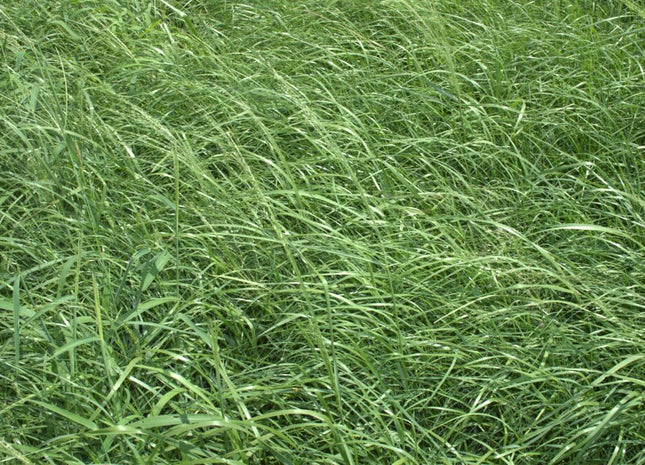
Teff Grass (HayMaker)
Teff makes a very palatable hay and is well accepted by all livestock types. Teff can be difficult to establish. It has a very tiny seed, much smaller than an alfalfa seed. It must be planted very shallow, about one-eighth of an inch deep, or seedlings will not emerge. Seedlings also need a week or so of moist soil to become established well enough to survive. This shouldn't be a problem with irrigation.
from $2.45 per lb

Perennial Shortgrass Blend
A mix of Canada bluegrass, sheep fescue, creeping red fescue and chewing fescue, this mix offers a great blend of grasses for your lawn, garden, or any sort of perennial mix.
from $4.95 per lb

Sorghum Sudan (Cattle Cover BMR MS)
Cattle Cover offers game-changing combination of agronomics and yield. High digestibility, great palatability, and strong disease package for overall good producibility. First-in-class sugarcane aphid tolerance. Agronomics and maturity makes it a strong hybrid for hay production and grazing. Being a male sterile it can be used where you do not want the possibility of volunteering.
from $1.60 per lb

Annual Ryegrass (Ranahan) - Tetraploid
Annual ryegrass stands out as a captivating and remarkable grass within the realm of cover crops. It offers a plethora of advantages, including winter grazing, impressive yields, and an often underrated impact on breaking through compacted soils. Notably, tetraploid ryegrass boasts rapid establishment, extended and broader leaves, but that comes with a reduced cold tolerance when compared to its diploid annual ryegrass.
from $1.00 per lb


Persian Clover (eNhance) - OMRI Inoculated
Every aspect of this plant supports its reputation for excellent forage quality. Mature stems are soft, hollow and have thin structural plant cell walls, leading it to be more digestible than red clover or alfalfa. Some common forage tests boast CP 16-21% and IVDMD 63-78%. Not to mention, studies have show persian clover to be more palatable than rape, alfalfa, fescue or perennial ryegrass. High productivity during March- April, provides excellent regrowth potential following grazing or the ability to support two spring hay cuttings. Given the right circumstances, one could expect persian clover to naturally reseed and be redistributed by wind/water via its very mobile, light weight, seed pods. Spring flowers are known to also attract flower flies, which larva are a leading predator of aphids. Learn more about eNhance Persian Clover here.
from $3.60 per lb


Perennial Ryegrass (Remington PLUS NE2 Endophyte)
Perennial Ryegrass is an extremely palatable cool season perennial forage source. While most perennial ryegrass lacks drought and heat tolerance, RemingtonPLUS, boasts improved ability to survive in hot and dry climates. The friendly endophyte associated with this ryegrass allows increased heat and drought tolerance. Perennial ryegrass is excellent quality forage and is a great option for grass finished livestock operations.
from $3.80 per lb


Sorghum Sudan (Short King BMR Dwarf PPS)
Short King BMR Dwarf PPS Hybrid Sorghum Sudan is an excellent option for people south of I-70 and in dry climates due to its superior drought tolerance and aphid resistance. This sorghum sudan can be used for hay production or grazing. It will maintain dwarf stature until the photoperiod sensitivity is triggered, usually mid-September.
from $1.75 per lb


Korean Lespedeza
Korean lespedeza is a low growing warm season annual legume known for it's ability to tolerate acidic and low fertility soil. They do most of their growing in the months of July and August. Though not high yielding, Korean lespedeza is very highly palatable and does not cause bloat. Annual lespedeza is a small seeded annual legume. Korean lespedeza can be frost seeded or drilled into pastures in midwinter or early spring, emerging in summer, or similarly seeded into a growing wheat crop for a hay or pasture crop after wheat harvest.
from $2.05 per lb

Winter Barley (P919) - Beardless
Barley has relatively low water usage compared to other cover crop species, especially during earlier growth stages. Under poor fertility conditions, barley would be a good choice and can help render P & K available for your next crop. Barley provides a good feed quality grain that can be harvested 2-3 weeks earlier than wheat which then allows your double crop/cover to be planted sooner. Compared to oats, barley produces more tillers and vegetation that will remain erect longer after termination. Carbohydrates known as monosaccharides are excrete through the roots to feed the soil biology and barley has been observed to release more monosaccharides than even alfalfa.
from $0.40 per lb

Tall Fescue (Teton II)
Teton II Tall Fescue is a high yielding, endophyte-free tall fescue variety suited for a multitude of environments. This tall fescue is deep-rooted, medium maturity, with excellent heat and drought tolerance. Learn more about Teton II Tall Fescue here.
from $5.10 per lb


Chicory (Endure)
Chicory is a deep rooted forb that goes great in many perennial pasture mixes. Because of its ability to reach many minerals in the soil, this is a highly nutritious grazing plant especially before it blooms with blue flowers. Chicory has natural deworming abilities adding to its benefits in perennial grazing systems where it should be seeded at a low rate for cattle but can be increased for sheep or other small ruminants.
from $5.00 per lb


Flax (Golden)
Flax can be utilized in many small grain and corn rotations as a potential cover crop or fiber/oil crop. Compared to other common crops, overall nutrient demand is lower and very little nitrogen is needed. Vegetative growth normally requires 50 days before flowering occurs but after this flowering can last 2-4 weeks. Flax can be utilized as a green manure if terminated early enough but take caution if attempting to cut too late as lignin/cellulose content increase with maturity and would hamper decomposition. Nearly 95% of the water flax extracts from the soil is in the top 2-3 feet because of its shallow root structure. Water use is considered moderate with respect to other field crops, but flax uses about 3-4 inches less than soybeans. This is primarily due to the fact that the leaves of flax are generally numerous but leaf area is limited and thus ET is lower. As mentioned before, this species is an excellent companion crop next to other species in an early season mixture. Flax is generally a self-pollinated crop but pollinating insects are attracted to the various blue/purple colors of the flowers. Because flax is a broadleaf species, most diseases associated with it will not transfer over and cause infection to corn, soybeans, or wheat with the exception of powdery mildew and rhizoctonia after legumes.
from $1.15 per lb

Forage Sorghum (Sweet Cane Max MS)
Sweet Cane Max is a medium maturity male sterile, forage sorghum. This hybrid fits well in a high-quality forage production or grazing operations. It has superior standability to other hybrids. Sweet Cane should be used in single cutting/grazing or winter grazing scenarios. When drying conditions are favorable it can be used for hay. Usually it is cut once the plant has headed out for highest sugar content or used for winter stockpile grazing. Sweet Cane will not produce grain unless pollinated with other sorghums, so isolation is recommended to protect sterility.
from $1.10 per lb

Aeschynomone (American Joint Vetch)
Aeschynomone, or American joint vetch, is a highly palatable warm season annual legume. Also known as deer vetch, joint vetch is particularly popular among food plot enthusiasts as it attracts wildlife such as whitetail, wild turkey, and bobwhite quail. American joint vetch not only provides excellent nutrition for large animals, but also excellent habitat for game birds. American joint vetch is an excellent way to add diversity to a mix and increase the nitrogen fixing capabilities.
from $7.55 per lb


Organic Mancan Buckwheat
Note: This product is certified organic. Buckwheat is a fast establishing broadleaf that works great as a warm season cover crop. Buckwheat is also known for being a phosphorus scavenger. Which means it can take up more phosphorus efficiently than other plants. Being a short season plant around 45-60 days, it can still produce viable seed throughout the growing season. In a situation where the one plant is grazed it can drop a seed down to take that previous plant's spot to help prevent weeds. This plant while dropping and producing these seeds can also flower making it a great species for pollinators.
from $1.20 per lb

Timothy Grass (Carson)
Timothy grass has excellent palatability while vegetative. It is an excellent species to use for hay, especially for horses. Though many varieties lack drought, heat, and grazing tolerance, Carson timothy is an improved variety and can be added to any cool season pasture.
from $3.20 per lb

Pearl Millet (Green Giant Hybrid)
Green Giant Hybrid Pearl Millet is among the best grazing or haying millet varieties. Pearl millet is very adaptable to its growing environment with great tillering ability. This allows for more forage and better ground coverage with less seed.
from $1.99 per lb


Triticale (Forage FX 1001 Triticale) - PVP
Forage FX 1001 Triticale is a beardless, high yielding forage forage triticale which can produce great tonnage on dryland acres. Forage FX 1001 is also the most cold tolerant triticale we offer. The reduced awn expression makes this variety an excellent option for grazing or haying. With excellent forage yield potentials this variety gives you the tonnage and the quality you are looking for. Forage FX 1001 is known to produce high amounts of forage even in low rainfall environments such as the western Great Plains regions.
from $0.33 per lb


Birdsfoot Trefoil (VNS) - OMRI Inoculated
Birdsfoot Trefoil is a long lived perennial legume. This plant contains high levels of tannins, making it an excellent addition to pastures for grazing as there is no bloat risk that is common with other pasture legumes. The tannins also help neutralize the impact of grazing endophyte infected fescue. Birdsfoot Trefoil is not as productive when compared to alfalfa and is most commonly used in mixtures with other plants.
from $7.35 per lb

Lab Lab (Highworth)
Lab lab is a highly palatable warm season legume native to Africa and Asia. It loves hot and dry conditions and is generally used as forage for livestock or in a food plot situation. Lab lab looks similar to a soybean plant, but generally grows taller and can be quite dense due to it's vining growth pattern.
from $2.35 per lb

Non-GMO Soybeans (KS5120NS)
These non-GMO soybeans are an excellent addition to a summer grazing crop, a post-small grain nitrogen fixing crop, or as a food plot for wildlife. It's a group 5 bean with indeterminate growth habit so the forage production potential is very high. This is a great, high protein forage for livestock.
from $1.00 per lb

Festulolium (SugarCrest)
SugarCrest Festulolium is a perennial ryegrass crossed with meadow fescue. This grass exhibits superior forage quality, winter-hardiness, drought tolerance, and excellent seedling vigor. This is a great option for anyone looking for a high yielding, high quality forage. Learn more about SugarCrest Festulolium here.
from $7.10 per lb


Smooth Bromegrass
Smooth brome is a productive, cool season grass with good drought tolerance. It has decent palatability though it is best grazed in a vegetative state. Smooth bromegrass is very aggressive, establishing quickly for a perennial and spreads through rhizomes, making a dense sod. This means it is great for waterways and holding soil on slopes but it can also dominate and even choke out other perennial species. For that reason, it should be used sparingly in pasture mixes, relying on other species which are more palatable and offer better regrowth, but using smooth brome to fill in.
from $3.60 per lb


Organic Jerry Spring Oats
Note: This product is certified organic. Spring oats are an excellent choice for quick ground cover in the spring or fall. Rapid growth aids in stabilizing disturbed or bare soil from environmental conditions. Spring oats make a great addition to any spring grazing or forage mix providing ample tonnage for your livestock. Fall plantings commonly winterkill. Residue from oats suppress winter annuals and protect the soil throughout the winter and will decompose rapidly in the spring. Allelopathic chemicals released by the decomposing residue suppress weed germination for a few weeks. The high quality oat forage is more palatable than rye or wheat. Also, oat is less prone to insect problems than either wheat or barley.
from $0.45 per lb

Intermediate Wheatgrass
Intermediate wheatgrass is probably the most productive of the western grasses, relatively equal to orchard grass, tall fescue, or smooth brome in yield potential, with much more drought tolerance. It is a strong bunchgrass and tends to lose quality upon maturity.
from $3.25 per lb

Turnip (Twister Hybrid)
Twister is a rapeseed x turnip hybrid making it an excellent cover and forage crop. This is a great addition to any spring, summer or fall grazing mix. This hybrid turnip will produce a highly palatable leafy green top sought after by livestock and wildlife alike. The foliage will quickly cycle nutrients if left to decompose.
from $2.50 per lb

White Mustard (Action)
Action white mustard is a superior white mustard variety known for its excellent nematode reduction properties. This variety is very quick to establish and forms lots of biomass in its early stages of life. Action mustard is very stable due to it's extensive root system making it well suited to strip-till situations. This mustard has a low likelihood of flowering so it will stay in vegetative stage for a longer period of time making it ideal as a grazing mustard.
from $2.50 per lb

Cereal Rye: Seed of Origin - KWS Serafino
Notice: This product may NOT be used for grain production, seed production, or mechanically harvested forage. Rye has an excellent fibrous root system that alleviates surface compaction. Rye can be successful planted later then almost any other cover crop due to its low germination and growth temperature requirements. Cereal rye is known for being the best cereal crop at retaining residual N. It's typical for a fall planted cereal rye crop to scavenge on average 25 to 50 lbs of N, with cases scavenging in excess of 100 lbs of N. The vigorous spring growth has successful weed suppression through competition and allelopathic chemicals. Rye can be terminated in the spring through the alternative methods of rolling, mowing, or crimping after boot stage. Rye will out yield any other cereal crops when planted in droughty, infertile, or sandy soils.
from $0.27 per lb

Italian Ryegrass (Tetlia/Tetra Prime)
Italian ryegrass is an excellent option for grazing. This high quality forage withstands close grazing which allows for total forage utilization. Italian ryegrass is generally considered a biennial. The Tetra Prime variety has improved winter hardiness along with excellent drought tolerance.
from $2.00 per lb

Arrowleaf Clover (Yuchi) - ORMI Inoculated
Arrowleaf clover is a cool season, reseeding annual legume. It is a multiple purpose plant material that can be used for grazing, hay production, a wildlife food source, soil improvement and a winter cover crop. Forage quality is high with digestibility generally superior to crimson clover at all stages of maturity. Deer and turkey readily feed on Arrowleaf clover.
from $3.25 per lb

Aberlasting Kura/White Clover - OMRI Inoculated
Aberlasting clover is a cross between caucasian and white clover. The excellent and high quality forage from the white clover mixed with the persistence under extreme stress conditions from the caucasian clover make a very adaptable and hardy clover.
from $6.60 per lb

Grazing Popcorn (Non-GMO)
This Non-GMO Grazing Popcorn is an excellent product for summer and fall grazing mixes as well as stockpile grazing mixes. Because corn tolerates cooler nights better than sorghum products, this is a great option for late summer planted grazing mixes. This seed is quite a bit smaller than the BMR corns so it stays in mixes and goes through a drill better than the larger BMR corn. While it doesn't contain the BMR trait which contributes to palatability, it is a better grazing corn compared to regular field corn and it will stand through the winter better than the BMR varieties.
from $0.75 per lb


German Millet (Strain R)
German millet is a warm season grass that can be planted earlier than sorghum sudan or pearl millet. Though it is not as productive as the aforementioned grasses, german millet makes a cost effective hay crop, ready for cutting about 55-60 days after planting. It does not have good regrowth which lends itself well to establishing the next crop without lingering competition after haying occurs.
from $0.90 per lb

Alyce Clover
Alyce clover is an excellent option for livestock and wildlife alike. Highly palatable and high yielding this plant provides excellent forage. Despite it's name alyce clover is not a true clover, but rather a warm season legume. This is an excellent option for summer forage, added to a warm season grazing mix, or as a wildlife food plot.
from $5.05 per lb

Organic Cereal Rye: Seed of Origin - KWS Serafino
Notice: This product may NOT be used for grain production, seed production, or mechanically harvested forage. Cereal Rye has an excellent fibrous root system that alleviates surface compaction. Rye can be successful planted later then almost any other cover crop due to its low germination and growth temperature requirements. Cereal rye is known for being the best cereal crop at retaining residual N. It's typical for a fall planted cereal rye crop to scavenge on average 25 to 50 lbs of N, with cases scavenging in excess of 100 lbs of N. The vigorous spring growth has successful weed suppression through competition and allelopathic chemicals. Rye can be terminated in the spring through the alternative methods of rolling, mowing, or crimping after boot stage. Rye will out yield any other cereal crops when planted in droughty, infertile, or sandy soils.
from $0.36 per lb

Intermediate Ryegrass (TetraMag)
Tetramag intermediate ryegrass offers high forage tonnage with great feed value. This variety offers great tolerance. Use a stand alone grazing or haying forage or utilize in addition with alfalfa or clover to offer a diverse feed for livestock. Planting can be done with a drill or broadcast as long as good seed to soil contact is achieved.
from $2.05 per lb

Alfalfa (MVS 4220Q) - OMRI Inoculated
This improved alfalfa variety from Mountain View Seed is bred for superior performance in yield, persistence, and quality. 4220Q is an excellent option for alfalfa growers across the country with high resistance to stem nematode and spotted alfalfa aphid, as well as resistance to pea aphid. This variety has a fall dormancy rating of 4 and a winter hardiness rating of 2.
from $5.85 per lb


Red Clover (Q Medium) - OMRI Inoculated
With similar forage yields, crude protein and better digestibility when compared to alfalfa, red clover can be an excellent forage alternative to add to your operation. You can harvest your first cutting 60-70 days after a spring seeding and on every 30-35 day intervals after initial harvest. With its vigorous spring growth, this clover has the capability of suppressing weeds. Red clover is less invasive than white clover because of its shorter life span and the lack of rhizome or stolon rooting structures. It's deep taproot can extend up to 3ft into the soil profile and finer rooting structure in the top 5" can really aid in breaking up compacted soils. Red clover flowers are known to attract many pollinator and beneficial insect species. If P leaching is a concern, red clover has been observed to leach only 1/3-1/5 the amount of P as ryegrass or radishes.
from $3.55 per lb


Grazing Corn (Solargraze BMR)
Grazing Corn is a high quality warm season annual option which is especially useful in late summer as the nights begin to cool off. Corn will thrive with warm days and cool nights, whereas sorghum sudan prefers hot days and warm nights. Grazing corn is highly palatable though it does not have great regrowth. For this reason it is best for a late season planting where only one grazing event is planned. It will also provide a high carbon residue to help protect soil during the winter.
from $0.60 per lb

Spring Oats (Everleaf Falcon) - Certified
Everleaf Falcon spring oats are an improved variety of oats. Delayed heading and improved leaf density make this an excellent option for forage. These oats resist lodging, produce excellent tonnage, and provide high quality forage. The seeds are much darker than most oat varieties, maturing as a medium to dark brown seed. Everleaf Falcon oats should be used for grazing or any type of harvested forage.
from $0.35 per lb

Sorghum Sudan (506x51 BMR Dwarf)
506x51 is a brachytic dwarf BMR sorghum sudangrass with a longer maturity than standard sorghum sudan hybrids. The 506x51 has a high tillering genetics that will help with filling in row spaces when planting at wider rows. This is also a benefit when grazing as once the plant is consumed the plant will stool. The delayed maturity benefit to this variety also pairs it nicely with longer season cover mixes that could be stock piled. The leaf to stem ratio is very attractive for a hay harvest planning as well.
from $1.55 per lb

Meadow Brome (Fleet)
Meadow brome is a bunchgrass resembling smooth brome but behaving more like orchard grass, only with more drought tolerance. Like orchard grass, it has good regrowth and is one of the better grasses for stockpiling in winter, though it is still distinctly inferior to fescue for that purpose.
from $4.05 per lb

Alfalfa (MVS Majestic) - OMRI Inoculated
Majestic alfalfa is a Mountain View Seed variety bred for quality and yield. This is a great variety to use in areas with a hard pan and/or a high water table as it expresses branch root trait. The sunken crown makes it ideal for grazing situations and areas with harsh winters. Majestic comes with an excellent disease resistance package and is rated 1.5 for winter hardiness and 3.9 for fall dormancy.
from $5.85 per lb
- Out of Stock


Organic Turnip
Note: This product is certified organic. Purple top turnips have been a staple grazing brassica for many years and are commonly used in late summer planted grazing mixes, often with a cool season cereal. Turnip bulbs are storehouses of nutrition and energy and are very valuable to winter grazers.
from $2.88 per lb
- Out of Stock


Organic Radish
Note: This product is certified organic. Rapid fall growth in short windows, allows radishes to fit perfectly into a traditional corn and soybean rotation. Radish residue breaks down very quickly in the spring, leaving a clean seed bed until early April. The residue has been proven to inhibit small seeded annuals from germinating. Nutrients that were scavenged are readily released back into the soil for the subsequent crop. A field planted in radishes, will allow the soil to dry and warm faster in the spring. The large root channel left behind is rich in nutrients, allows tremendous water infiltration, reduces water erosion, and a path for crops roots to follow through compacted soil layers. During decomposition, radish biofumigates the soil which can reduce pest and nematode populations.
from $3.07 per lb
- Out of Stock


Organic Brown Flax
Note: This product is certified organic. Flax can be utilized in many small grain and corn rotations as a potential cover crop or fiber/oil crop. Compared to other common crops, overall nutrient demand is lower and very little nitrogen is needed. Vegetative growth normally requires 50 days before flowering occurs but after this flowering can last 2-4 weeks. Flax can be utilized as a green manure if terminated early enough but take caution if attempting to cut too late as lignin/cellulose content increase with maturity and would hamper decomposition. Nearly 95% of the water flax extracts from the soil is in the top 2-3 feet because of its shallow root structure. Water use is considered moderate with respect to other field crops, but flax uses about 3-4 inches less than soybeans. This is primarily due to the fact that the leaves of flax are generally numerous but leaf area is limited and thus ET is lower. As mentioned before, this species is an excellent companion crop next to other species in an early season mixture. Flax is generally a self-pollinated crop but pollinating insects are attracted to the various blue/purple colors of the flowers. Because flax is a broadleaf species, most diseases associated with it will not transfer over and cause infection to corn, soybeans, or wheat with the exception of powdery mildew and rhizoctonia after legumes.
from $1.92 per lb
- Out of Stock


Organic Crimson Clover
Note: This product is certified organic. Kentucky Pride is an improved variety of crimson clover selected for more cold tolerance and more production (taller, deeper roots, more basal leaves and more tillering) than varieties like Dixie. Kentucky Pride crimson clover is a very fast establishing clover.
from $3.05 per lb
- Out of Stock

Organic Hairy Vetch VNS
Note: This product is certified organic. Hairy vetch is one of the most winter hardy legumes. Being more winter hardy than common vetch, hairy vetch has the potential to withstand temperatures in excess of 5F with no cover. This species is known to have a great rooting system, with a tap root that will extend 1 to 3 feet into the soil profile. This taproot will allow the vetch to thrive even in dry conditions. When hairy vetch is placed into a mix, it can help bring the C:N ratio of the mixture down. This reduces the risk of nitrogen immobilization for the next crop.
from $2.95 per lb
- Out of Stock


Organic 4010 Spring Forage Pea
Note: This products is certified organic. Spring peas are one of the fastest growing spring legumes. Planted in spring after the harshest winter cold has passed, spring peas will tolerate some light freezing. Peas are commonly planted with oats as a high quality spring feed either for hay or grazing or even a green manure.
from $0.72 per lb
- Out of Stock


Organic Austrian Winter Peas
Note: This product is certified organic. Austrian winter peas are good companions to fall mixes, especially when combined with hairy vetch. If planted in early fall, there can be good growth for fall grazing as a protein source in the mix and they will grow much later into the fall than spring peas. In order to maximize winter survival chances, winter peas need to be planted relatively late (about the middle of wheat planting season) and deep, up to 3 inches. These conditions will help protect the growing point of the pea and assists in survival in colder climates.
from $1.00 per lb
- Out of Stock


Organic Rushmore Spring Oats (Certified)
Note: This product is certified organic. Spring oats are an excellent choice for quick ground cover in the spring or fall. Rapid growth aids in stabilizing disturbed or bare soil from environmental conditions. Spring oats make a great addition to any spring grazing or forage mix providing ample tonnage for your livestock. Oats can be easily chemically terminated and fall plantings commonly winterkill. Residue from oats suppress winter annuals and protect the soil throughout the winter and will decompose rapidly in the spring. Allelopathic chemicals released by the decomposing residue suppress weed germination for a few weeks. The high quality oat forage is more palatable than rye or wheat. Also, oat is less prone to insect problems than either wheat or barley.
from $0.50 per lb
- Out of Stock


Organic Hazlet Cereal Rye
Note: This product is certified organic. Cereal Rye has an excellent fibrous root system that alleviates surface compaction. Rye can be successful planted later then almost any other cover crop due to its low germination and growth temperature requirements. Cereal rye is known for being the best cereal crop at retaining residual N. It's typical for a fall planted cereal rye crop to scavenge on average 25 to 50 lbs of N, with cases scavenging in excess of 100 lbs of N. The vigorous spring growth has successful weed suppression through competition and allelopathic chemicals. Rye can be terminated in the spring through the alternative methods of rolling, mowing, or crimping after boot stage. Rye will out yield any other cereal crops when planted in droughty, infertile, or sandy soils.
from $0.36 per lb
- Out of Stock


Organic Elbon Cereal Rye
Note: This product is certified organic. Cereal Rye has an excellent fibrous root system that alleviates surface compaction. Rye can be successful planted later then almost any other cover crop due to its low germination and growth temperature requirements. Cereal rye is known for being the best cereal crop at retaining residual N. It's typical for a fall planted cereal rye crop to scavenge on average 25 to 50 lbs of N, with cases scavenging in excess of 100 lbs of N. The vigorous spring growth has successful weed suppression through competition and allelopathic chemicals. Rye can be terminated in the spring through the alternative methods of rolling, mowing, or crimping after boot stage. Rye will out yield any other cereal crops when planted in droughty, infertile, or sandy soils.
from $0.51 per lb

Forage Sorghum (Sorgrow D120 BMR Brachytic Dwarf)
This Brachytic Dwarf Forage Sorghum brings a jump in yield potential. Excellent standability, top-notch quality feed and now featuring our Aphix SCA tolerance. This is a benchmark of all high-yielding forage sorghum products in the lineup. If you need a product to push the limits of yield and provide superb agronomics, this is the one to try.
from $2.18 per lb





